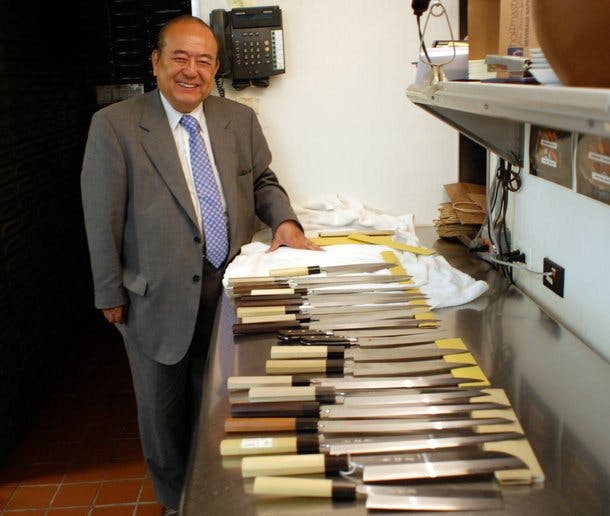
Buy a Japanese Knife
Explore the world of Japanese kitchen knives and the significance of these unparalleled cooking utensils rooted in the rich history of Japanese food culture. Learn about the traveling knife salesman from Japan, Mr. Yuichi Hiruko of Filco Corporation, who delivers high-quality blades to chefs and maintains old-school relationships with customers.
While working at Matsuri, I heard of a traveling knife salesman from Japan who regularly visits restaurant kitchens across America. I asked Chef Ono if he could order a knife for me the next time this man showed up at the restaurant. That happened two months ago. The other week my blade arrived.
I've been trying to find a left-handed gyuto, an all-purpose kitchen knife, for a while now with no luck, even in Japan. I was looking for a blade tapered on one side only, in traditional Japanese style, hence the hunt for the lefty blade. (Western kitchen knives are tapered on both sides, of course.) These one sided knives let you make smoother, more precise cuts, which is why sushi blades are honed this way -- so you can effortlessly cut through the soft flesh of fish.
I've been fascinated by Japanese knives for a while now (see my post and story in Salon). Here's what the Japanese food scholar Dr. Naomichi Ishige says about knives in his remarkable book "The History and Culture of Japanese Food" (Totally out of print and unavailable except in libraries, what a shame):
"For Japanese cooks, the hocho, the Japanese kitchen knife, is the equivalent of the samurai's sword. The hocho is so much a symbol of a cook than in Japan a cook is known as a 'knife wielder'... When a cook moves from one restaurant to another he takes his own hocho with him. A chef gauges the skill of a new cook by examining his hocho to see where it was made and how it has been maintained."
(By the way, I met Dr. Ishige once and he told me about his amazing life, including living with nomads in the Libyan desert, and with headhunters in Papua New Guinea. Wow!)
The gentleman pictured above, Mr. Yuichi Hiruko of Filco Corporation, is the knife salesman who helps keeps this sensibility alive. We met when he delivered my blade. His company is based in Sakai, the historic home of Japanese metalcraft. On this trip he had a couple of hundred knives with him, which he was delivering to chefs across the country. He develops personal relationships with chefs and visits new restaurants only through word-of-mouth. And even in today's credit card age, the way he works is decidedly old-school: He takes your order on trust, and you pay when he delivers your blade.
Mr. Hiruko explained to me that he expects his customers to learn how to care and sharpen their blades before he sells them a knife. He works with "knife wielders" to find the blade that fits them perfectly.
My gyuto has a 12-inch steel alloy blade with a traditional handle turned from Japanese magnolia. I needed one big enough to handle large portions of ingredients you typically find in a restaurant kitchen. It's unbelievably sharp and precise, gliding through even raw carrots effortlessly. The other night Chef Ono walked over to watch me cut and told me my technique is getting better. It's not me. It's my knife.
If you're interested in one of Mr. Hiruko's knives, let me know and I'll try to pass the information along. His knives are expensive, as you'd expect, and you'll have to wait a while -- but definitely worth it.
Here's another passage from Dr. Ishige's book:
"The cutting edge of the Japanese sword has long been renowned as the sharpest in the world. Before Japan's borders were closed in the seventeenth century, swords were one of the main items exported to China and Southeast Asia. Japanese swords are forged, by a unique method, of steel obtained from iron sand and melted in a specially designed forget before being patiently hammered. High-grade kitchen knives are handmade by the same process. In the days when swords were commonly produced, the same smith often made both swords and hocho."
And an interesting part about sushi knives:
"The sashimi-bocho, a long, narrow knife with a single-taper edge, is used for preparing sashimi and for other fine cutting. Sashimi usually consists of pieces of a fillet from which the skin has been removed, sliced into pieces of uniform thickness. Because of its soft texture, raw fish would crumble is a knife were brought down upon it from the top. In preparing sashimi, therefore, one pulls the sashimi-bocho straight towards oneself so that the long blade draws through the piece of fish."
